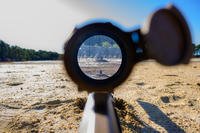USS Durham, we hardly knew you.
Ships and aircraft from ten nations participating in the Rim of the Pacific exercise sank the former amphibious cargo ship in a dramatic live-fire exercise Aug. 30, according to Navy releases.
Durham, a Charleston-class amphibious cargo ship, entered service in 1969 and was decommissioned after 24 years in 1994. The 575-foot, 10,000-ton ship, which deployed in support of the Vietnam and Gulf War conflicts, was stricken from the Naval Vessel Register in 2015, and has since awaited disposal at the Pearl Harbor, Hawaii Naval Inactive Ship Maintenance Facility.
The sinking exercises, or SINKEX, with former U.S. Navy warships are a regular part of RIMPAC, the world's largest biennial international maritime warfare exercise. This year, the exercise involved ten nations, 22 ships, one submarine, and approximately 5,300 personnel. It was held Aug.17-31 near the Hawaiian Islands.
Read Next: MOH Recipient Ron Rosser Dies at 90
SINKEXs aim to develop proficiency and confidence in various weapons and systems for participating units through realistic training that could not be duplicated in simulators, a Navy release states.
"Simulation is a critical part of our training but there is nothing better than to conduct live fire training," Royal Australian Navy Capt. Phillipa Hay, commander, RIMPAC 2020 Task Force One, said in a statement. "Sinking exercises are an important way to test our weapons and weapons systems in the most realistic way possible. It demonstrates as a joint force we are capable of high-end warfare."
Former Navy warships designated for sinking, known as hulks, are prepared strictly under Environmental Protection Agency regulations and in line with the Marine Protection, Research and Sanctuaries Act, officials said.
Each hulk is sunk in at least 1,000 fathoms, or 6,000 feet, of water and at least 50 nautical miles from land, with surveys that ensure people and marine mammals are out of the dangerous area during the exercise, according to the Navy.
The Navy said each vessel also undergoes a rigorous cleaning process to remove any harmful chemicals, particularly, liquid polychlorinated biphenyls (PCBs) from transformers, large capacitors and small capacitors; and to get rid of all trash, floatable materials, mercury or fluorocarbon-containing materials and readily detachable solid PCB items. Petroleum is also cleaned from tanks, piping, and reservoirs.
Additionally, a Navy environmental, safety and health manager and a quality assurance supervisor take responsibility for environmental remediation following a SINKEX. Upon completion of the environmental remediation, the manager and supervisor provide signed certification of the work under EPA requirements.
-- Bing Xiao can be reached at bingxiao2020@u.northwestern.edu.













